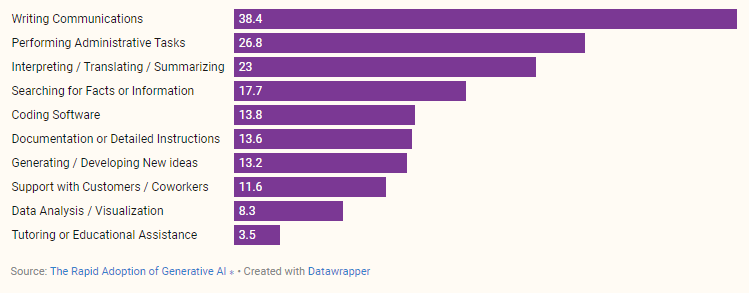Your employees are using AI, and you don’t know it.
Right now, a quiet revolution is happening in workplaces everywhere. Employees are using artificial intelligence to transform their work, and many bosses have no idea it’s happening.
This is not speculation. Multiple* research studies are now showing us that a large percentage of professionals are adopting AI on the job.
65% of marketers, 64% of journalists, and even 30% of lawyers are using AI in their daily tasks.

The result is productivity increases by 25-30% and even more in MANY cases.
Amazon notably found massive increases in software developer productivity, with their AI-driven coding assistant saving 4,500 developer-years of work and $260 million in annualized efficiency gains.
I know these figures can seem like hypebole, so here’s some sources with notes on the survey size and background:
- The Rapid Adoption of Generative AI (Federal Reserve/Harvard/Vanderbilt) (survey of 7,565 U.S. residents between 18 and 64 years old, conducted between June 2024 and August 2024)
- The Adoption of ChatGPT (UChicago/Statistics Denmark) (survey of 100,000 workers from 11 occupations in Denmark, conducted between November 2023 and January 2024)
- Slack Research: AI at Work (Survey of 10,281 workers in the U.S., Australia, France, Germany, Japan and the U.K. between January 10 and January 29, 2024)
- Amazon AWS DevOps Blog (August 2024): Amazon Q’s $260 million milestone, including productivity gains and efficiency improvements
But here’s the catch – most of this AI use is happening in secret.
Employees are turning to AI but keeping it to themselves.
In conversations I’ve had with business leaders and employees in Ireland, the UK, and the US, this trend is obvious. And others are noticing this trend too. Professor Ethan Mollick from the Wharton School describes this as the “Secret Cyborg” phenomenon, and he describes some common reasons people don’t share their AI:
They received a scary talk about how improper AI use might be punished. Maybe the talk was vague on what improper use was. Maybe they don’t even want to ask. They don’t want to be punished, so they hide their use.
They are being treated as heroes at work for their sensitive emails and rapid coding ability. They suspect if they tell anyone it is AI, people will respect them less, so they hide their use.
They know that companies see productivity gains as an opportunity for cost cutting. They suspect that they or their colleagues will be fired if the company realizes that AI does some of their job, so they hide their use.
They suspect that if they reveal their AI use, even if they aren’t punished, they won’t be rewarded. They aren’t going to give away what they know for free, so they hide their use.
They know that even if companies don’t cut costs and reward their use, any productivity gains will just become an expectation that more work will get done, so they hide their use.
They are incentivized to show people their approaches, but they have no way of sharing how they use AI, so they hide their use.
Employees are quietly getting along with adding AI to their workplace toolkit, but managers remain largely unaware.
This is important because companies are missing out on huge opportunities for improvements across the organisation.
Worse still, they are left unprepared when it comes to issues like loss of company proprietary data, privacy/GDPR, and mis-use of AI.
How can you bring AI into the open in your company?
Here are four steps that will help:
- Provide comprehensive AI training and resources:
- Implement AI training programs for all skill levels
- Develop a curated list of approved AI tools for each department
- Create an internal knowledge base for AI best practices and use cases
- Establish an AI support team to assist employees
- Establish clear, non-punitive AI policies:
- Draft transparent guidelines on appropriate AI use in the workplace
- Define parameters for acceptable AI experimentation
- Outline processes for reporting and addressing AI-related concerns
- Regularly update policies to align with AI advancements
- Implement incentives for AI transparency:
- Introduce an “AI Innovation Award” for outstanding employee-discovered use cases
- Incorporate AI proficiency into performance evaluations and career advancement criteria
- Offer incentives for sharing successful AI implementations
- Create opportunities for employees to present their AI discoveries to leadership
- Encourage executive-level AI adoption:
- Have executives share their personal experiences with AI tools
- Incorporate AI demonstrations into company-wide communications
- Encourage leadership participation in AI training alongside employees
- Highlight how AI informs high-level decision-making processes
The goal is to reduce fear of A) using AI, and B) disclosing use of AI. This normalises and promotes AI use, reducing fear and secrecy. When employees feel comfortable using and discussing AI, you get the most from these incredible tools while managing associated risks.
AI is a rapidly evolving field, so it’s crucial to maintain open communication with your team about what is effective and what is not. Be prepared to be adaptable.
You might be wondering about the best way to start. Consider selecting one of these steps to implement this week. Begin with a small-scale trial, assess the results, and expand from there. The sooner you start this process, the quicker you’ll see tangible outcomes.
What’s your perspective? Which of these steps do you think would be most effective in your organization? Is AI openly discussed in your workplace, or is it still hidden?
If you need assistance with AI training or AI policy development, I’m here to help. Schedule a consultation with me, and we’ll work on implementing robust systems and processes to support your team.









